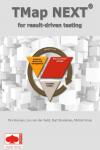TMap NEXT® offers the tester and the test manager guidelines to deliver results for the client. Flexible by design, TMap NEXT offers a comprehensive and consistent approach to project and program test management, execution and quality assurance, suitable for all types and sizes of organizations. It is an adaptive method suitable for all test situations in most development environments, such as new development, maintenance, waterfall/iterative/agile development, customized or package software.
Through the years, TMap evolved into a de facto standard for testing information systems. It is currently implemented in hundreds of companies and institutions all over the world. The power of TMap can be largely ascribed to the many experiences from actual practice that it incorporates. This makes the book a valuable tool for current and future challenges in the field of testing.
What is TMap NEXT?
TMap NEXT is an approach to structured testing. TMap NEXT was published in 2006 and it is still the standard way of testing for many organisations that use a traditional (waterfall or V-model) approach. For high-performance quality engineering (such as agile or DevOps) we refer you to the renewed TMAP.
Using TMap NEXT has the following advantages:
- It delivers insight into, and advice on, any risks in respect of the quality of the tested system.
- It finds defects at an early stage.
- It prevents defects.
- The testing is on the critical path of the total development as briefly as possible, so that the total lead time of the development is shortened.
- The test products (e.g. test cases) are reusable.
- The test process is comprehensible and manageable.
The 4 essentials
The specific TMap content of a structured test approach can be summarised in four essentials.
- TMap is based on a business-driven test management (BDTM) approach
- TMap describes a structured test process
- TMap contains a complete tool box
- TMap is an adaptive test method
The first essential can be related directly to the fact that the business case of IT is becoming ever more important to organisations. The BDTM approach provides content that addresses this fact in TMap and can therefore be seen as the ‘leading thread’ of the second essential, the structured TMap test process.
The TMap life cycle model is used in the description of the test process. Furthermore various aspects in the field of infrastructure, techniques and organisation must be set up to execute the test process correctly.
TMap provides a lot of practical applicable information on this, in the form of e.g. examples, checklists, technique descriptions, procedures, test organisation structures, test environments and test tools. This toolbox is the third essential.
TMap also has a flexible setup so that it can be implemented in different system development situations: both for new development and maintenance of a system, for a self-developed system or an acquired package, and for outsourcing (parts of) the testing process. In other words, TMap is an adaptive method. This is the forth essential.
Major benefits
Key benefits of the TMap NEXT risk-based approach to project and program testing include:
- A structured but flexible test process ensures a consistent focus on meaningful and essential client-specific metrics and a deeper understanding of associated risks.
- The detection of defects moves back down the total development lifecycle; early defect identification and quality management ensure that overall quality targets are met or exceeded.
- A shorter testing period on the critical path of the total development cycle helps business meet its time-to-market timescales and reduce costs.
- A repeatable and reliable test process means that time is saved next time round, and the time after that.
- Consistency, standardization and knowledge transfer means a common language for all involved – business, technical, supplier partners – helping to embed testing knowledge in the organization.

